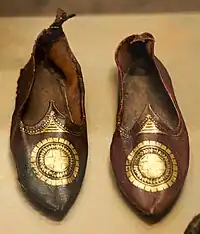Pigache
The pigache, also known by other names, was a kind of shoe with a sharp upturned point at the toes that became popular in Western Europe during the Romanesque Period. The same name is also sometimes applied to earlier similar Byzantine footwear.

Names

The English name pigache was borrowed from French, where the name was originally used for a kind of hoe and as a hunting term for a wild boar hoofprint longer on one side than the other.[2] It appeared in Medieval Latin as pigacia[3][4] and pigatia.[5] The pigache is also known as the pigage,[6] pulley shoe,[7][8] pulley toe,[1] or pulley-toe shoe.[9] Less often, Orderic Vitalis's terms of opprobrium are reworked into names: scorpion's tail or ram's horn shoe.[10] The name pigache is also sometimes also applied to earlier pointed Byzantine footwear from as early as the 5th century.[11] It is also simply glossed as a pointed-toe shoe[12] and sometimes conflated with the later poulaine.
Design
.jpg.webp)
The pigache had a pointed and curved toe,[6] which Orderic Vitalis compared with the tail of a scorpion[4] (quasi caudas scorpionum).[3] The shoes were sometimes stuffed to make the extension firmer and more erect. The end of the toe was sometimes adorned with a small bell.[6] The points of pigaches were, however, more moderate in length than the later poulaines[4] which spread from Poland in the 14th century.
History

The pigache was worn in the late 11th[12] and early 12th century[6] and excited the ridicule of poets and historians and the censure of clergy[4] to the point it is sometimes described as "notorious".[8] St Anselm banned its use by English clerics at the 1102 Synod of Westminster, alongside enacting the Gregorian Reform and prohibiting slavery, sodomy, clerical marriage, and the inheritance of benefices and other forms of simony.[13] As a returning papal legate, the former professor Robert de Courson banned other faculty of the University of Paris from wearing them in August 1215.[14] The same year, the Fourth Lateran Council also banned them for Catholic clergy.[15][16] Orderic Vitalis blamed the creation of the pigache on Fulk of Anjou[7] (1043–1109), claiming he used it to disguise the deformity of his bunions[4][17][3] from his young bride Bertrade in 1089.[18][19] The fashion historian Ruth Wilcox offers that it may have been a simple adaptation of the Normans' sabatons, which they had extended to a point and turned down in the late 11th century to better hold their stirrups during battle.[20]
The pigache became common in England under William Rufus (r. 1087–1100), whose courtier Robert the Horny (Robertus Cornardus)[17] used tow to curl the ends of his shoes into the form of a ram's horn[4] (instar cornu arietis).[21] Orderic blamed the spread as caused by and contributing to the effeminate men (effeminati) and "foul catamites" (foedi catamitae) involved in the royal courts of Europe,[17] while simultaneously describing how most courtiers adopted the fashion to "seek the favors of women with every kind of lewdness".[22][23] William of Malmesbury similarly condemned the shoes in terms questioning the wearers' masculinity.[1] Guibert of Nogent, while no less dismissive, associated the style more with women and blamed its origin on footwear exported from Islamic Cordoba, whose residents he separately associated with effeminacy and homosexual rape.[1]
After its initial excesses reaching about 2 inches (5 cm) beyond the foot,[20] the style settled into a more conservative and compact form for a century until the Black Death and the spread of the still more excessive poulaine style from Poland in the mid-14th century.[12]
References
Citations
- Rubenstein (2019), p. 38.
- D'Alembert (1751).
- Chibnall (1973), pp. 186–187.
- Planché (1876), p. 459.
- Chibnall (1973), pp. 190–193.
- Bossan (2012), p. 266.
- Aird (2016), p. 196.
- Coatsworth & al. (2018), p. 349.
- Yarrow (2011), p. 112.
- Yarwood (1980), p. 163.
- Lewandowski (2011), p. 229.
- Yarwood (1978), p. 366.
- Perry (1890), p. 190.
- Robert de Courson (1215).
- Alberigo & al. (1973).
- Dittmar & al. (2021).
- Mills (2015), p. 82.
- Schibanoff (2006), p. 36.
- Aird (2008), pp. 127–128.
- Wilcox (1948), p. 65.
- Chibnall (1973), pp. 186–189.
- Mills (2015), p. 83.
- Chibnall (1973), pp. 188–189.
Bibliography
- Aird, William M. (2008), Robert Curthose Duke of Normandy (c. 1050–1134), Woodbridge: Boydell Press, ISBN 978-1-84383-660-5, archived from the original on 14 August 2023, retrieved 4 August 2023.
- Aird, William M. (2016), "Orderic's Secular Rulers and Representations of Personality and Power in the Historia Ecclesiastica", Orderic Vitalis: Life, Works, and Interpretations, Woodbridge: Boydell Press, pp. 189–216, ISBN 978-1-78327-125-2, archived from the original on 14 August 2023, retrieved 4 August 2023.
- Alberigo, J.; et al., eds. (1973), "Concilium Lateranense IV a. 1215" (PDF), Conciliorum Oecumenicorum Decreta (in Latin), pp. 230–271, archived (PDF) from the original on 12 July 2023, retrieved 12 July 2023.
- Bossan, Marie-Josèphe (2012), The Art of the Shoe, New York: Parkstone International, ISBN 978-1-78042-958-8, archived from the original on 14 August 2023, retrieved 21 December 2021.
- Coatsworth, Elizabeth; et al. (2018), Clothing the Past: Surviving Garments from Early Medieval to Early Modern Western Europe, Leiden: Brill.
- D'Alembert, Diderot, ed. (1751), "Pigache", L'Encyclopédie (in French), vol. XII, Paris, p. 610.
- Dittmar, Jenna M.; et al. (December 2021), "Fancy Shoes and Painful Feet: Hallux Valgus and Fracture Risk in Medieval Cambridge, England", International Journal of Paleopathology, vol. 35, Los Angeles: Paleopathology Association, pp. 90–100, doi:10.1016/j.ijpp.2021.04.012, hdl:2164/17718, PMC 8631459, PMID 34120868.
- Lewandowski, Elizabeth J. (2011), The Complete Costume Dictionary, Lanham: Scarecrow Press, ISBN 978-0-8108-4004-1, archived from the original on 14 August 2023, retrieved 4 August 2023.
- Mills, Robert (2015), Seeing Sodomy in the Middle Ages, Chicago: University of Chicago Press, ISBN 978-0-226-16926-2, archived from the original on 14 August 2023, retrieved 4 August 2023.
- Orderic Vitalis (1973), Chibnall, Marjorie (ed.), The Ecclesiastical History..., vol. IV, Oxford: Clarendon Press.
- Perry, George Gresley (1890), A History of the English Church: First Period: From the Planting of the Church in Britain to the Accession of Henry VIII. (596–1509), The Student's English Church History (5th ed.), London: John Murray, archived from the original on 14 August 2023, retrieved 4 August 2023.
- Planché, James Robinson (1876), A Cyclopaedia of Costume..., London: Chatto & Windus, archived from the original on 12 July 2023, retrieved 3 July 2015.
- Robert de Courson (1944), "Rules of the University of Paris", in Thorndyke, Lynn (ed.), University Records and Life in the Middle Ages, New York: Columbia University Press, pp. 103–105, archived from the original on 5 July 2022, retrieved 12 July 2023.
- Rubenstein, Jay (2019), Nebuchadnezzar's Dream: The Crusades, Apocalyptic Prophecy, and the End of History, Oxford: Oxford University Press, ISBN 978-0-19-027420-7, archived from the original on 14 August 2023, retrieved 4 August 2023.
- Schibanoff, Susan (2006), Chaucer's Queer Poetics: Rereading the Dream Trio, Toronto: University of Toronto Press, ISBN 978-0-8020-9035-5, archived from the original on 14 August 2023, retrieved 4 August 2023.
- Wilcox, Ruth Turner (1948), The Mode in Footwear, New York: Charles Scribner's Sons, ISBN 978-0-486-46761-0, archived from the original on 14 August 2023, retrieved 4 August 2023.
- Yarrow, Simon (2011), "Men and Masculinities at the Courts of the Anglo-Norman Kings in the Ecclesiastical History of Orderic Vitalis", The Haskins Society Journal: Studies in Medieval History, vol. 23, Woodbridge: Boydell Press, pp. 115–124, ISBN 978-1-84383-889-0, archived from the original on 14 August 2023, retrieved 4 August 2023.
- Yarwood, Doreen (1978), Illustrated Encyclopedia of World Costume, London: B.T. Batsford, ISBN 978-0-486-43380-6, archived from the original on 14 August 2023, retrieved 4 August 2023.
- Yarwood, Doreen (1980), Costume of the Western World..., Cambridge: Lutterworth Press.

